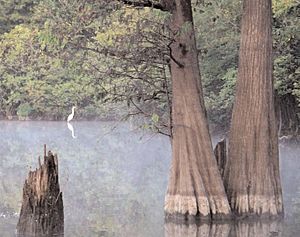D'Arbonne National Wildlife Refuge facts for kids
Quick facts for kids D'Arbonne National Wildlife Refuge |
|
|---|---|
|
IUCN Category IV (Habitat/Species Management Area)
|
|
| Location | Ouachita and Union Parish, Louisiana |
| Nearest city | West Monroe, Louisiana |
| Established | 1986 |
| Governing body | U.S. Fish and Wildlife Service |
| Website | D'Arbonne National Wildlife Refuge |
D'Arbonne National Wildlife Refuge is a special place in Louisiana. It is a National Wildlife Refuge of the United States. This means it is a protected area where wild animals and plants can live safely.
The refuge is located north of West Monroe, Louisiana. It stretches across Ouachita and Union Parish, Louisianaes. It sits on both sides of Bayou D'Arbonne. This is near where the bayou meets the Ouachita River. The refuge was created in 1975. Its main goals are to protect important forests. It also provides a winter home for birds that migrate. D'Arbonne is one of four refuges managed by the U.S. Fish and Wildlife Service in North Louisiana.
A Home for Wildlife
The refuge has 13 miles of Bayou D'Arbonne flowing through it. Many smaller creeks, sloughs (slow-moving water channels), and oxbow lakes (U-shaped lakes) also crisscross the area.
These waterways and different types of forests create many homes for animals. You will find Cypress swamps here. There are also bottomland hardwood forests and upland forests. Bottomland hardwood forests grow in low, wet areas. Upland forests are on higher ground.
Many cool animals live here! Look for the American alligator. You might also spot the Rafinesque's big-eared bat. The bald eagle, which is the national bird of the United States, also lives here. Another special bird is the red-cockaded woodpecker.
When there is a lot of rain, the refuge's bottomland hardwood forest often floods. This usually happens between January and May. Up to 87% of the refuge can be underwater. These flooded forests are very important for wildlife that needs wetlands. They also help reduce damage from floods in nearby towns. The forests filter dirt and pollution from the water. They also help refill underground water sources called aquifers.
Fun Things to Do
You cannot camp inside the D'Arbonne National Wildlife Refuge. However, there are places to camp nearby. You can find camping areas in Lake D'Arbonne State Park.



